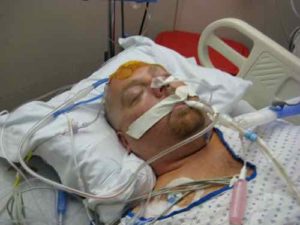One Decade Since My Hemorrhagic Stroke

Ten years ago today I thought I was going to die on my cold concrete bedroom floor. It was the afternoon and I thought I suddenly got a headache. I laid down on the bed then decided to go into the bathroom and take an aspirin. That’s when I realized I wasn’t going to be able to remain standing, so I lowered myself to the floor. I thought I should call 911 but I couldn’t think of where my phone was. I began vomiting…a lot. I pulled the comforter off the bed for some warmth.
I heard my phone ringing, it was in the kitchen. I couldn’t move.
I began realizing that I was likely to die — one month to the day after my dad. I thought about loose ends I hadn’t taken care of. Then I must’ve blacked out. The next morning my close friend Marcia used the emergency key I gave her to check on me. Apparently I was conscious and told her to grab my phone so she could call my brothers.
It was Saturday February 2nd — the big Mardi Gras parade meant the emergency room was busy. Marcia and other friends waited amongst the ill party goers. I was at St. Louis University hospital for more than 3 weeks. In that time I had many visitors, though I was sedated most of the time.
My friends Rich & Andrew, from Seattle & Kansas City, respectively, arrived a week after my stroke. Thankfully Rich documented his visit and my condition.
This is a good place to discuss the types of strokes:
All types have one thing in common: a loss of blood to part of your brain. That causes big problems.
Your brain cells need the oxygen that’s carried by your blood. So when a stroke cuts the supply, some of the cells start to die. And that sets off trouble like memory loss, confusion, and numbness on one side your body.
There are two main types of stroke:
- Ischemic
- Hemorrhagic
If you have signs of any of them, call 911 right away. The sooner you get treated, the less likely you are to have long-term effects. (webMD)
Ischemic, caused by a blood clot, is far more common than the type I had, hemorrhagic.
My first memory after February 1st is of waking up on February 25th. I’d been transported to St. Mary’s on Clayton Rd to begin therapy, a cousin and one if my brothers was there. Two trips in an ambulance and I have no memory of either!
On the 25th I had a trachea (voice box) in my throat, initially I thought it was permanent. Even once I knew it was only temporary I would pull it out — nurses had to restrain my right arm to prevent me from interfering. No need for them to strain my left side — I had zero movement. After nearly 41 years as a leftie I would need to become right-handed.
By the 28th I was allowed to eat foods and drink liquids — I had to pass a swallow test first.
Therapy (physical/occupational/speech) should begin within hours/days after a stroke — but it was several weeks in my case. Before leaving St. Mary’s on March 21, 2008 friend Antonio French stopped by to document my progress.
On March 21, 2008 one of my brothers drove me to a now-closed state rehabilitation facility in Mt. Vernon MO. There I continued to work on physical, occupational, and speech therapy. On April 30, 2008 myself and a few others from the St. Louis region were taken to our respective residences.
During these first three months after my stroke I wasn’t sure what my future would be like. I didn’t know I’d be able to live well on a fraction of my prior income. I didn’t know just 5 years later I’d find love. I didn’t know I’d be forced to narrow my focus and rethink my priorities.
Ten years ago today I thought I was going to die — but it was the day I really began to live!
— Steve Patterson